-
June,
27: Stereoscopic applications-page
restructured and updated.
===========================
-

June,
25: H3D Eyewear is now also available from
Mindflux, Australia.
===========================
-
June,
25: The initial version of the Imagek
Electronic Film System will have a 100 ASA rating, which is a bit low
for poor Loreo/Argus. The price should be somewhere below $1000. Release
date: 4th quarter '98.
===========================
-
June,
21: There are 3D-photo-cameras, but no 3D-digital-still-cameras
yet, which is a major concern for many stereo freaks and professionals.
Don't despair, help is underway, but in a shape you never might have imagined.
By the end of the year Imagek www.imagek.com
releases the "Electronic Film System". A digital CCD-sensor & storage
system in the shape of a standard 35 mm film. Just put it into any standard
cam or 3D-cam (like the Loreo)
and off you go at 1280x1024. It stores up to 30 shots and connects to the
PC.
Let's
hope it won't be as expensive as I think it'll be.
===========================
-
June,
18: Brightland
the company behind H3D-Quake develops a stereo image viewing and manipulation
utility.
Here's
what they have to offer:
"We
have been working with stereo3D since 1987 (we created the first
stereo3D
game on the Amiga, SpaceSpuds, and the first stereo3D game on
the
PC, VR Slingshot. We are also working on a new stereo3D game; see
http://www.brightland.com).
We have worked with StereoGraphics, 3DTV,
Chinon,
NuVision, VRex, and H3D. We ported Quake to stereo3D for H3D,
and
provided them with the software technology to produce their new
wireless
shutter glasses. We've been thinking about selling our viewer
program,
which allows users to composite stereoscopic images in
real-time.
This means that the user can adjust cropping, vertical and
horizontal
parallax, position, rotation, and scale, all in real-time.
The
user can simply drag and drop stereo pairs (either eye as .jpg, .tga
or
.jps (both eyes)) into the viewer for editing. For viewing content,
the
user can zoom in or out in real-time, and the image is resolution
enhanced
so that no pixels are ever seen. For example, the low-res
images
available on the net as "samples" look quite good in our viewer
at
1280x1024 in stereo (no pixels are visible). Zooming in on areas of
interest
is also very cool, as the resolution is continously enhanced,
and
the stereo looks superb. We also have the technology to do fully
automatic
stereoscopic image compositing (and not just joining images
together:
proper stereo compositing) for large batches of images."
John Schultz
President and CEO
Brightland Corporation
Brightland
hasn't decided yet how to distribute the program. They're open to bundling
deals with hardware manufacturers and are considering a shareware release.
The
program supports interlace and above-below format for all systems which
can handle this. H3D
is also supported!!!
Please
tell them what you think, how much you would spend on such a program and
what features you're looking for. Don't just say you would only spend two
pennies on it or this baby will never go gold <g>.
===========================
-

June,
17: Germany: Typhoon (Woobo) Cyberboy shutterglasses
for DM 39 (about $22) at Comtech. The glasses work for many DOS-titles
by default and can be greatly enhanced (windows, etc.) by building your
own homebrew controller.
===========================
-

June,
15: Jürgen
Hunke wrote a Win95 Frontend for the "merge.exe" Dos program to make
stereoscopic gif files for the Cyberview viewer supplied with the Cyberboy
Shutterglasses from Woboo. It's freeware and makes it more comfortable
to use merge.exe, especially if there are larger amounts of left/right
images to merge.
Please
stand by for a download address or request the file by email from Jürgen.
===========================
-

June,
15: The dream is over!? IISVR
(Interactive Imaging Systems - former Forte) released the specs of their
highly anticipated next generation consumer HMD VFX-3D.
The resolution increased from 180,000 to 230,000 pixel per eye. That's
a 28% increase in resolution in 4 years of development! - My condolences.
Looks
like LCD-cost remains a major problem. Early sources indicated true 640x480
support. Please correct me if I'm wrong, but my calculation goes like this:
640x480 = 307,200 pixels, but we'll need triads (red/green/blue) of LCD-pixels
to get color. That makes: 640x480x3 = 921,600 pixels.
===========================
-

June,
15: Some readers asked me how to order the
VR-Joy glasses. There's an order form on www.vr-joy.com
(I hope it works). Click the "JOIN NOW" button on the main page or go there
directly: http://www.vr-joy.com/adult/preview/frame_joinnow.html.
This
is an adult-website! I hope this is of no concern.
===========================
-
June,
14: Check out this great website on medical
issues related to binocular vision: www.vision3d.com.
(Thanks to Jean-Marc for
the link.)
===========================
-
June,
11: Opposed to my earlier statement on the
VR-Joy page the 3D-SPEX
glasses work fine on the VR-Joy controller when it comes to voltage (sorry
for the slip-up). The original SPEX-controller works at 12V, the VRJoy-controller
at 9V. At higher voltages the SPEX becomes a bit darker, but even at 9V
the shutter-performance is sufficient. The ghosting is about as good or
bad as usual. Remains the reversed-wiring which shouldn't be that
much of a problem. The adaptor for reversing the two contacts is an easy
job. So, in case you already own one of the two systems buying the other
is a good idea. You'll get two pairs of glasses and the SPEX-parallel port
controller helps keeping stereo-orientation stable on certain LCD-BIOS
titles. The VR-Joy controller does all the other stuff. The same applies
to other wired serial or parallel products (Cyberboy, APEC, 3DTV and others).
===========================
-
June,
10: Orthoptiste (kind of specialized optometrist)
Jean-Marc Desvals developed a system based on 3D-Max
for the treatment of patients with binocular-vision disorders (orthoptic
therapy). The system is now in clinical evaluation. Visit his web-page
at http://www.mls.nc/users/jmd/vt.htm
(in french & hopefully also in english soon). Here you'll also find
an interlace format image for testing stereoscopic vision ability.
===========================
-

June,
5: Please welcome my first sponsor: Stereo3D-hard-
and software-distributor 3DIST. Visit them at www.3dist.com.
===========================
-
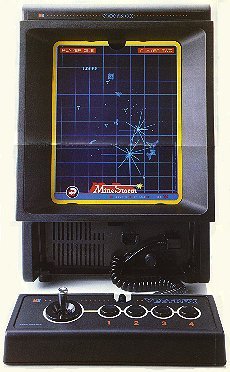
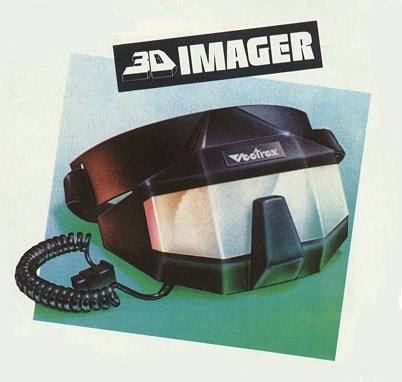
June,
2: Just saw the Vectrex 3D-glasses from the
golden 80's on german TV. I couldn't breathe as long as the thing was on-screen.
I thought I must be dreaming. How comes? There was a report about the Computer-
& Videogames-Museum in Berlin. They have a pair. On the museum homepage
www.computerspielemuseum.de
I learned that the Vectrex glasses were in fact a shutter-system, but not
with LCD's as I thought. It was mechanical! The thing used a rotating disk,
one half black, one half colored to give 3D and color to the monochrome
vector-monitor. Each game had a different color scheme disk. Oh man, that's
what I call a collectors item - Coooooool.
Unfortunately
there is no product shot on the homepage. They have the same concept drawing
from the product flyer as I use it on my pages. BTW I'm proud to have the
original flyer (in german!).
The
system is now more expensive than it was when it came out. Forget about
coins and stamps - start collecting this kind of stuff!
===========================
-
June,
1: Updated the VR Joy review. If you already
read it you might take another look. New items: wiring is reversed compared
to some other brands of wired glasses; Line-Blanker drawbacks; comment
on VR-Joy homepage.
===========================
-

May,
30: Sick of fiddling around with 3D-
and VESA-drivers? Still no go on titles like Terminal Velocity or Comanche
3 ? Your web-browser shows flat images only? Your VGA-board is of no use
when it comes to 3D-ing? Help is here! The new VR-JOY
creates interlace on any hardware at the push of a button! Read THE REVIEW
now! As usual it's long, detailed and mercyless!
===========================
-
May, 26:
The homebrew sync-doubler controller was finally build and tested by it's
developer Florian Schreck. The circuit layout is available now. A new page
with a more detailed description for electronics-dummies follows soon.
The do-it-yourself project requires some wired shutterglasses and 2 days
work. The controller works for H3D-software on 3Dfx Voodoo Graphics 1 &
2 boards and for all other split-screen-3D-software. This also covers Duke3D
and all the professional stuff for pro-shutterglasses, like the StereoGraphics
CrystalEyes.
The
new sync-doubler address is: http://ag-rempe.physik.uni-konstanz.de/privat/florian/lcd/index.html
Florian's
Cologram page moved to: http://ag-rempe.physik.uni-konstanz.de/privat/florian/cologram/index.html
===========================
-
May, 26:
Finally a web-page dedicated to the CyberMaxx.
http://home.t-online.de/home/tietz-frost/cmaxx.htm.
The page is hosted by Klaus Tietz and his companion. (Under construction!)
===========================
-
May, 26:
The new Olympus Eye-Trek is a HMD almost as
small and light as shutterglasses (110 g). It features two 180k-pixel displays
and a video-in port for TV/Video-uses. It even runs on battery for 3 hours
(optional). Available in Japan only. (This information was derived from
VRNews magazine http://www.vrnews.com
)
===========================
-
May, 26:
I was told the VESA3-miniDIN-3 shutterglasses
connector on the Hercules Thriller 8MB vanished for a S-video-in port.
The pins for the shutterglasses-control-signal still seem to be on the
board, so there might be a "do it yourself" solution. (Thanks to Franz-Hubertus
Beck, http://fhbeck.home.pages.de)
===========================
-
May, 26:
Check the new SD&A conference site at
http://www.stereoscopic.org
===========================
-
May, 26:
New H3D-Fan page by Nik Odolphie at http://surf.to/eastfield
===========================
-
May, 26:
According to the senior programmer of Bethedsa
Softworks the company is working on a new 3D-engine which will support
H3D and the 3D-API's: Glide (3Dfx), Direct3D and OpenGL.
They
also did a Glide(3Dfx)-plus-H3D version of their current engine which is
used by "Burnout". There should be a H3D-Burnout in the forseable future.
Wait a moment - Isn't that the dragster-car-race-sim? Uhhh, this one got
very bad reviews over here, even worse than Andretti Racing! (Thanks to
Marc Bejarano for the info.)
===========================
-
May, 26:
I was asked if it would be possible to build
an alternate H3D-transmitter to make H3D glasses compatible to non-H3D
software. Well, I don't see a point for a new IR-transmitter, but what
about a new controller? Based on the circuits for the homebrew VGA-PT,
serial and parallel controllers someone could build a controller with a
mini-DIN-3 connector for the H3D-IR-transmitter, instead of the usual connectors
for wired-glasses. In my theory this device wouldn't require the H3D-line-code
and could work on LCD-BIOS etc. The problem? I don't know the signaling
of the H3D-mini-DIN-3 port. H3D told me it's different from the VESA3-mini-DIN-3
signaling. (Thanks to Nik http://surf.to/eastfield)
===========================
-
May, 26:
Reflection Technology - www.reflectiontech.com
- developed a miniature LED-VGA-display suitable for HMD's. Here's what
they claim to be the advantages of LED over LCD:
Smaller
Lower Cost
Lower Power Consumption
Higher Contrast
Resolution Scalability
More Rugged Display
Superior Color
100% Image Fill (no gaps
between pixels as in LCD's)
Full Color Pixels (a single
pixel appears in whatever tint, opposed to the red/green/blue triads in
LCD's)
I guess there'll be backdraws
as well.
The current version (P7)
offers true 640x480 in 4096 colors at 60 Hz. It'll be manufactured by Omron,
a large japanese company.
I don't know of any HMD
which uses this technology yet.
===========================
-


May,
10: New hardware-independend shutterglasses!
The VRjoy glasses, distributed by G-WORLD COMERCIAL LTDA and manufactured
by Woobo, are wired and got a VGA-pass-through controller. Seamless Windows
desktop support. No driver software required! (Sounds like a line-blanker
device to me.) They should work on any graphics-card. The glasses are available
NOW. As you can see from the related websites the product seems to be targeted
at the adult market. The (adult) sample images for the VRjoy are done in
the usual interleaved line (interlace) format. More stuff is available
to website members.
Since
Woobo is the manufacturer I wouldn't be surprised if the VRjoy is similar
to the upcomming Cyberboy II.
Check
the websites: http://www.vr-joy.com,
http://www.cyberstereoimage.com/
, http://www.woobo.com/english/eng.html
(this Woobo link bypasses the stupid "under-construction-page")
Yes,
I know what you're gonna ask next: Will it work with H3D titles? Well,
I don't know, but here's my guess (just a guess): Voodoo Rush and Rendition
- Yes; Voodoo Graphics and Voodoo 2 - No!
===========================
-
May, 10:
There are still some HMD's not listed in my
HMD-chart, like the Olympus Mediamask or the Shimadzu STV-E. I'll add them
later.
===========================
-
May, 10:
Philips introduces a new goggle-less 3D-LCD-monitor.
(http://www.research.philips.com/generalinfo/special/3dlcd/index.htm).
The "7 View 3D-LCD" uses a lense-grid known from those 3D-postcards and
cornflakes-box collector pix. As far as I understand the technology, the
interleaved image lines has to be vertical opposed to most other 3D-solutions,
like shutterglasses, HMD's or the VRex micro-pol stuff. In other words:
the thing is compatible to nothing.
===========================
-
May, 10:
H3D
released a miniGL beta which enables Voodoo2 support.
===========================
-

May,
10: Here's a funny hint by "Mindtrap" (mindtrap@teleport.com).
He got the VRex VRSurfer Classic Pack working with H3D-GL-QuakeII. He connected
the TV-controller to the TV-out of his Voodoo Rush board. It works on the
TV screen as well as on the VGA-monitor. I guess this procedure limits
the refresh rate to 60 Hz !?! Should work on Rendition and other GL-boards
with TV-out too. NOOOOO, it won't work with Voodoo Graphics or Voodoo2
of course, even if they got a TV-out!
===========================
-
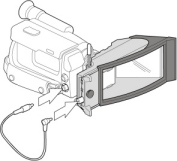
May,
6: More on the 3-DVideo
Nu-View Stereo3D-camcorder adaptor. The February 1998 issue of "Camcorder
& ComputerVideo" magazine featured a 5 page review of Nu-View.
(3D-Video Inc. was so kind to provide me with a copy.) The adaptor works
just like I assumed (refer to the last News-issue).
Here
are some additional details:
-
The exact model name is "Nu-View SX2000"
-
The add-on is attached to the filter-thread and tripod mount of a standard
camcorder. It should fit most existing models. (I'm a bit concerned about
this new ultra-small miniDV-camcorders though. It also requires a standard
video-out which must be active and accessible during filming.)
-
The dimensions are (HxWxD) 3.1 x 7.3 x 3.6 inches (at max). (7,6 x 17,9
x 8,8 cm)
-
The weight is 11.5 ounces (326 grams).
-
The shutter is powered by one standard AAA 1.5 Volt battery which lasts
about 50 hours.
-
The system is automatically shut-down when the video signal goes away (i.e.
if the cam is shut-down).
-
There is a convergence control to account for the distance between camera
lens and bayonet mount.
-
The recorded material can be edited, just like any standard video recording.
No new equipment required.
-
Zooming is possible!
-
Since only one lens is involved there are no problems with coordinating
focus, white balance and such.
The
Nu-View is much cheaper and easier to handle than earlier 3D-cam or two-camera
solutions. It's able to use the full potential (which isn't that great)
of the current tv-systems. Since it's an optical device it could even work
with future advanced tv-systems, even HDTV. I don't know which frequencies
it could handle apart from the current 50/60 Hz though.
What
really matters is the way you watch the 3D-video material.
The
easiest and cheapest way is to use a standard 50/60 Hz TV-set with some
TV-shutterglasses, but this solution yields the most flicker.
There
are more advanced ways to watch the tapes by using:
-
100/120 Hz digital TV-sets
with built-in (!!!) shutterglasses controller.
-
stereo LCD-HMDs like the i-glasses (LCD
is too slow to cause serious flicker)
-
2-LCD-projectors with
polarization filters (like offered by APEC)
-
Digital transfer to the PC
(like offered by APEC)
3D-Video
Inc. and myself received some emails expressing fears concerning paning
and moving. Due to the time-sequential recording technique used by the
system the 3D-effect could (in theory) be distorted by movements.
The
developers point out that this isn't a problem. Even paning shots, shots
out of a fast car and other movements didn't show any unwanted effects.
With
other solutions too expensive, too inferior or not yet available the Nu-View
seems to be the king of the hill - for now.
Please
note that I haven't actually tested the system myself yet!
BTW
I got an interesting hint by Ross Cutler.
He was also concerned about the time-lag problem and came across the new
Canon Optura miniDV
consumer camcorder which uses a progressive scan CCD. The camcorder plays
to the rules of the current TV-systems by recording 50/60 half-frames a
second, but it seems to scan the two half-frames (which represent one full-frame)
at the same fraction of time, thus eliminating the usual time-gap between
half-frames.
===========================
-
.

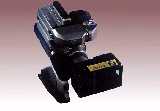
April,
27: Measured by the feedback I got in the
last two weeks 3D-Video seems to be the thing on most minds at this time.
I took another look at the Nu-View consumer camcorder 3D-adaptor distributed
by 3-DVideo. The APEC
adaptor should be quite similar. Here's my idea of how it works. This information
isn't backed up very well, just assumption! As you know there's not much
info on the corresponding web-pages.
Now how does such a camcorder
3D-adaptor work. Well it's like shutterglasses for your camcorder eye.
A mirror system puts the camera lens into the center of the light rays
of a left and a right eye view. A built-in shutter sees to it that the
camera lens gets only one of the views at a time. The adaptor is connected
to the video-out port of the camcorder. This way the shutter can sync to
the recording (50 or 60 Hz).
To understand the technology
you first have to understand our television systems. One second of television
consists of 25 (PAL) or 30 (NTSC) frames. These frames are divided into
50 (PAL) or 60 (NTSC) half frames. One half-frame consists of either
all even or all odd lines of a frame. In other words television works in
interlace mode by default. 3D-video systems are based on this interlace
technique. They use all even-line-half-frames for one eye and all odd-line-half-frames
for the other eye. Like any shutterglasses system it's time-sequential
stereo!
The resulting 3D-video tape
is similar to the commercial 3D-video
tapes sold over the net and can be viewed with all TV-shutterglasses
systems or a video-ready HMD like
the i-glasses. No further modification of camcorder, VCR or TV-set required!
APEC
offers a digitizer system to get the videos onto the PC. The port to the
PC gives you the opportunity to increase the refresh rate (but not the
frame-rate or resolution).
I don't think that ordinary
television with it's dreadfully low resolution and refresh is a good basis
for a 3D-system. Nevertheless I would like to get my hands on an adaptor,
but I'm not happy with the current price tag!
===========================
-

April,
26: I received hints regarding i-glasses headtracking
from many contributors in the last few weeks. I put one of them on the
Legacy page.
BTW
I don't own any headtracking device. There's very little good software
support. One of the few titles done right seems to be Flight Unlimited
where the plane is controlled by joystick/pedals and the pilots view by
headtracking. In most programs the headtracking just replaces the joystick/mouse
to control body or vehicle movement. I think that's NONSENSE! What would
happen in real life, when steering a car by headtracking??? Yeah, you guessed
it - bullshit!
There's
also a new headtracking-ONLY helmet on the market. Man - steering your
stuff with hands and fingers is painful enough. Moving your head wildly
for hours to control an action game? - Ridiculous!
===========================
-

April,
26: New dedicated H3D-page: Peter's
(?) H3D-Fan-Page
===========================
-
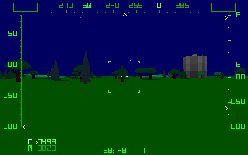
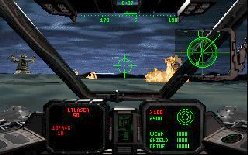
April,
26: German market: I found a mail-order source
(Weltbild) which offers Shattered
Steel (full retail) and Cyberbykes for DM 5,- each. Both titles work with
almost all Stereo3D devices. Check the German
Market page for the order numbers. If you got the Weltbild-catalogue:
it's issue 5/98, page 211.
===========================
-
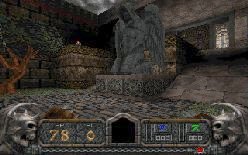
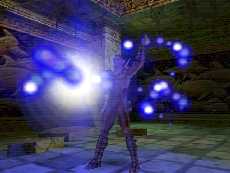
April,
24: New official H3D-announcements:
Hexen2 and Herectic2 by Raven.
===========================
-
April,
24: As you might know from the H3D-News
page there's an interview with the H3D-staff in RealVideo on GameTime.
Since the interview is rather long (1 hour) here's a summary of what I
found new & interesting:
-
The H3D controller actually amplifies the VGA-signal to prevent signal-losses.
That's the reason the signal goes away when the dongle isn't powered.
-
H3D doesn't seem to be interested in an API or a 3D-engine which gives
developers Stereo-support by default on their own. They want to actively
participate in every single software project for quality-assurance.
-
Voodoo 2 support is the No.1 on H3D's To-Do-List, so it's just a matter
of time until it's done. Reportedly they had to wait for a stable V2-code
base to do their magic on it.
-
Voodoo 2 SLI mode (two boards) with 1024x768 Z-buffered will be supported.
-
1024x768 is the max. resolution the H3D-controller can handle.
-
The 3D-accellerator chipsets, H3D concentrates on, are 3Dfx and Rendition,
with NVidia next on the list!
-
H3D is developing new versions and add-ons to the glasses: different designs,
different colors, alternate nose-pieces, frames and most important: larger
LCD-panels!!!
-
With the curent know-how provided by H3D a software developer should be
able to incorporate H3D support into his product within 3 to 4 days! The
devolpement of H3D-Quake1 took 5 month, but this was a R&D project.
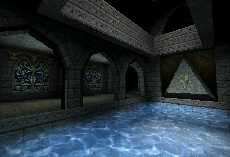
-
Unreal (Epic Megagames): H3D can't announce this officially yet, but they're
very interested in this title and are in close contact to the developers.
-
Forsaken (Acclaim): H3D is interested in this title too. They talked to
the developers, but it's unclear if this game will be ported.
-
H3D talked to tons of software developers including Activision, GTInteractive
and Epic.
-
H3D tries to get support in MS DirectX.
-
H3D is mainly interested in A-class titles.
-
Retail distribution: H3D will start retail distribution when there's a
basis of about 20 to 25 A-class software titles available.
-
3D-sound may be incorporated into the eyewear in the future.
-
Big announcements by H3D to follow in the near future!
===========================
-
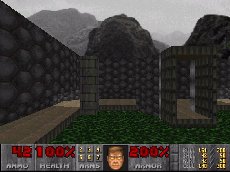
April,
20: There's another version of Stereo3D-Doom,
written by Andy Bay.
Like Nuvisions Doom it's also done
with the WinSPEX SDK . Actually it came out before Nuvisions version. Andy
told me about his project month ago, but somehow I lost track of it. Please
try both versions and tell me which one is better. Andy's version is available
HERE and may yield some
other interesting features.
===========================
-
April,
20: Added a Stereo3D-Acceleration chart (sorted
by 3D-API's) to the Hot-List.
Rendition won over 3Dfx - for now.
===========================
-
April,
18: Stereo3D-FAQ
released. Covers everything, including Titanic <g>.
===========================
-
April,
18: H3D
to raise prices by $30 on May, 1. If you're interested in this system you
should order now. BTW I think even the new, higher price is still competitive.
Other sync-doubler systems cost hundreds of $$$ and lack H3D's line blanker
for future H3D-Windows desktop applications.
===========================
-
April,
16: New 3D-video website: 3-DVideo.
Camcorder adaptor, glasses, HMD, etc.
===========================
-
April,
16: New 3D related website opening soon (!?!):
Innerdimension.
===========================
-
April,
16: New 3D related website: AIS
- Advanced Intelligence Systems. Hardware, software and 3D-images.
===========================
-
April,
11: New Shutterglasses: Tetratel
EyeFX VR.
===========================
-
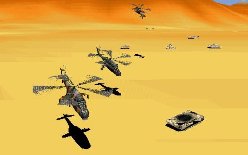
April,
11: HEXAGON KARTELL
The
retail version of Hexagon Kartell is on the cover of german games magazine
PC Action plus, issue 4/98 (DM 16,90 = $9). It constists of 2 CD's, since
there are lots of cut-scenes. It's a para-military helicopter action simulation
with a storyline - drug-lords and such - set in the year 2004.
The
program was released in mid 97 and is completely in german language. There
is no english version! The Publisher is Ascaron.
The
game features native stereo3D-support for:
VFX-1
(2x320x240), including headtracking (?) and cyberpuck
i-glasses
(2x320x200), no headtracking (?)
3D-Max
(2x512x350)
The
i-glasses mode works for VR-Surfer and 3D-SPEX (Nuvfrag) too. (As usual
setup might be tricky and there could be a stereo-reverse problem in some
instances.)
All
the necessary patches are included on the CD's. The i-glasses patch is
supposed to add SimulEyes support too, but I couldn't find that mode yet.
I would
describe the 3D-effect in i-glasses mode as poor, but I haven't seen much
objects yet since I didn't really played the game. I just took a quick
look. Basically I see 2 layers of depth: the cockpit and the outside. The
depth of the objects out there is insignificant. Maybe there's a function
to set up the depth, but I have yet to look for it. A similar problem occured
with Shattered Steel where the depth was also poor at first.
I can't
tell much on the quality of the game as such yet. I've read in a magazine
that the mission-design is good. The graphics are not quite up-to-date
but not bad either. There's no 3D-accelerator support.
Haven't
tested the hi-res 3D-Max mode yet, got to reinstall the 3D-Max ISA-board
first. The 3D-Max version doesn't work for any other system.
The
magazine can be backordered from the publishers.
===========================
-
April,
11: 3D-MANIA
Christian
Przewalla just told me that there's an anaglyph (red-blue or
red-green) stereo3D game called 3D-Mania. It's a 3D-Tetris variation.
===========================
-
April,
11: H3D started international shipping. Fortunately
they offer a 220 Volt power supply for 10 extra bucks.
===========================
-
April,
5: Stereo 3D Mailing List! Upon request I
decided to offer the Stereo3D-News as a mailing list, so you don't have
to check this page every now and then. Send me an e-mail
with "SUBSCRIBE 3D-NEWS" as the subject. See to it that your "reply-address"
is defined correctly.
The
content of the mailings will be equivalent to the news on this page. As
usual updates will happen irregularly.
===========================
-

April,
5: The Woobo
main page is still under construction and the "english section" button
is deactivated, but you'll find the old
pages here. Might be of help in case you need some patches or stuff.
(Thanks to Matteo for the hint.)
===========================
-
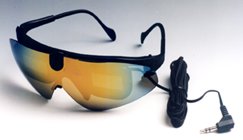
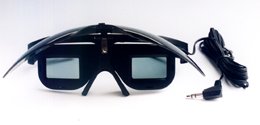
April,
3: See what's behind the Goldeneye! A new
shot of the upcoming APEC-II-Gold
glasses with visor-up. (Thanks to APEC for the update.)
===========================
-

April,
3: DOOM SPEXIFIED !!!  I must be dreamin' !!! Nuvision
(the SPEX-guys) did Stereo3D-WinDOOM for WinSPEX !!! Might work with Doom2
etc. too! It's not a first rate stereo conversion, but a technology demo
to show how easy it is to do stuff for WinSPEX. Go to the Nuvision SPEX-Doom
page! BTW, this port isn't authorized by "id" !
I must be dreamin' !!! Nuvision
(the SPEX-guys) did Stereo3D-WinDOOM for WinSPEX !!! Might work with Doom2
etc. too! It's not a first rate stereo conversion, but a technology demo
to show how easy it is to do stuff for WinSPEX. Go to the Nuvision SPEX-Doom
page! BTW, this port isn't authorized by "id" !
===========================
-

April,
3: i-glasses Win95 drivers now available on
Denis Bolic's VR-Page.
===========================
-

April,
3: VRex
website overhauled. New design, but no apparent new product info yet. Ohh
well, the new Gallery is great!
===========================
-

April,
3: H3D
will accept international orders very soon!!! They hope to get their e-commerce
server up and running by Wednesday, April 8. There's still no 220Volt version
yet, so if you're living in a 220-country get your stabilized, universal
power adaptor ready (available everywhere for about $15 upwards).
===========================
-
April,
3: Scitech Display Doctor 6.5 released. New
Stereo-functions ??? - I'll check that later.
===========================
-

April,
3: Hexen 2 is a budget title in Germany now.
Softprice-Label: 29,95 DM UVP (about $16). Some dealers didn't react yet
and still offer it for 90,- DM - Hands Off!
===========================
-

March,
27: SPEX-News: WinSPEX 2.3 out. Now
supports more chipsets and boards with VESA-DIN-3 stereo connector. Get
it from Nuvision.
New
european SPEX-distributor! Anubis
offers the Nuvision 3D-SPEX as "Typhoon Cyber Toy". The distribution
of the "Typhoon Cyberboy" (Woobo) seems to have stopped. Cyberboy --> Cybertoy.
Wow. How creative!
(Thanks
to Thomas
for the news.)
===========================
-

March,
26: New dealer emerging in Europe: Italian
Hardware Research. They will distribute products by Woobo. The website
is under construction. It should open sometime in April.
===========================
-

March,
26: i-glasses driver page at Mindflux
updated! (Thanks to Mindflux-W-Master Jason
Pang.)
===========================
-

March,
26: Cyberboy at Vobis
in Dortmund for DM 49,-. It's unclear if this is a local clearance-sale
or if Vobis throws out it's Cyberboy remainders all over Germany. (Thanks
to Robin Maytum
for the info.)
===========================
-
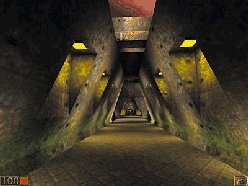
March,
23: Font and Target Fix for H3D-GL-Quake
II. H3D-Q2 is just out and there's already a hack which makes the font
readable and fixes the target/crosshair. On Todd
M. Purcell's H3D page you'll find the fix and MORE!!!
===========================
-

March,
22: Chancellor Dr. Helmut Kohl, head of german
government, finally found his way into Stereo-heaven, wearing a pair of
Stereographics CrystalEyes.
He attended a 3D-demonstration by the University of Darmstadt at CeBIT'98
Hannover, Germany, the largest computer and telecommunications fair in
the world - and growing. (Photo taken from Welt
a.S. - BTW the headline was: "Blick in die Zukunft" - A look into the
future!)
===========================
-
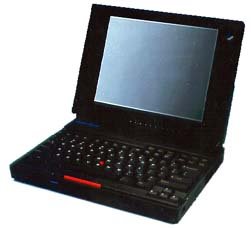
March,
22: In a CGW
article about Stereographics, VRex and Nuvision I found the following
statement:
"VRex’s
passive products are based on the company’s MicroPolarizer
Array
(m Pol) technology, which can be incorporated into any LCD
display,
including the newer desktop LCD monitors. m Pol doesn’t affect
2D
viewing at all. "We hope that somewhere in the year 2000 we’ll have
some
critical mass, and we’ll have a good percentage of the [monitor]
market
with [m Pol] built in," says VRex’s Saporito.
VRex
is working with such firms as SGI, IBM, and Samsung to try to
persuade
them to incorporate m Pol technology into their new monitors. In
fact,
the company is refining its manufacturing technology so that OEMs
will
be able to include m Pol technology in their new LCD monitors for less
than
$20 apiece."
20
Bucks for a $3000 screen, that's about the same story as with this 1 dollar
for the DIN-3 port on certain $200 graphics cards. And we know how such
stories end... sad.
===========================
-
March,
20: H3D-GL-Quake2,
H3D/3DFX-Glide 2.45, H3D-GL-Quake1 update and H3D-DOS-Quake1 update OUT
!!!!
===========================
-
March,
20: Voodoo 2 users will have to wait for Glide
3.0 to get H3D support. Oh man, waiting,
waiting, waiting... that's the fate of stereodicts.
===========================
-
March,
19: Did some testing on the drivers discussed
below:
SVRDOS32.DRV
& ZAR & Univbe: It works! I saw it at 140 Hz refresh now!
SVRDOS32.DRV
& Whiplash & Univbe: Program runs, but I can't get a video signal,
screen stays black, no matter what parameters used.
SVRDOS32.DRV
& Whiplash & S3-VESA-driver: No change.
SVRDOS32.DRV
& Shattered Steel & Univbe: No change, still stuck at 78 Hz.
SVRDOS32.DRV
& Madspace & Univbe: No change, still stuck at 78 Hz.
SimBIOS
& Nascar & Univbe: It works in lo-res. Can't get into hi-res
because Simbios doesn't accept the "-h" command line parameter, it's just
a syntax problem.
SimBIOS
& Magic Carpet: No luck.
Results
will vary on different hardware. You got to try it yourself.
===========================
-
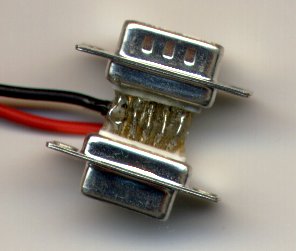
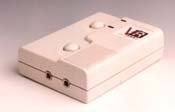


March,
19: Very Important for All SimulEyes and
VGA-Pass-Through Users!!!
There
are some interesting files on the StereoGraphics
SimulEyes FAQ
page (or go directly to the FTP
dir)
The
DOS-driver SimBIOS replaces LCD-BIOS. It does for the SimulEyes/fanatix
what NuvFrag does for the SPEX and more. It works for LCD-BIOS titles and
alternate line (HMD and such) titles which use VESA modes. DOS-Quake, Cyberbykes,
Nascar Racing (hi-res), Descent 1&2 and maybe Hexagon Kartell should
work this way. There's not much hope for Comanche3, Armored Fist2 and Terminal
Velocity, since they don't use VESA modes, but I'll try it anyway. I'm
not shure about Magic Carpet and Hi-Octane (3D-BIOS stuff).
SimBIOS
does even more! It works in protected mode and avoids real mode,
as such it doesn't interfere with other TSRs. And here's the best. It solves
the lo-res refresh problem by remapping VGA 320x200 to VESA 640x400.
That means programs like Whiplash will finally react to the refresh setting
in Scitech Display Doctor - Yiiiieeeehaaaaw. Performance should also improve
by this.
There's
more, SVRDOS32.DRV is a replacement driver for native SimulEyes
titles. Usually native SimulEyes titles (like Whiplash, Shattered Steel,
ZAR and such) contain LCD-BIOS code for software (!) page-flipping.
The new driver will try to use hardware (!) page-flipping on the latest
VGA-chipsets instead. Supported chipsets incluce: Rendition Verite 1000
and 2200, Alliance AT3D or AT25 with 3DFX VoodooRush, 3DLabs Permedia2,
NVidia Riva 128 (no pal, I don't think that'll make the SimulEyes work
on H3D-GL-Quake). The driver will also improve performance and refresh
rate on other chipsets by using VESA 2.0/3.0 instead of VGA. Should also
help on the stereo-orientation-flip problem, discussed here.
I guess StereoGraphics wrote this driver in preparation for their upcoming
consumer VESA-3 glasses, so they can utilize the existing SimulEyes titles
right away.
There
are also new Windows 3.x/95/NT interlace DLL's.
These
drivers should be pure gems for all SimulEyes, miro fanatix, i-Art, VR97,
Cyberstuff and homebrew VGA-PT users. The white line code is optional and
can stay off !!! - Very convenient for non-SimulEyes users.
I haven't tested any of
this stuff yet. I'm very very short on time at the moment. Just try it
yourself and drop me a line.
(Thanks
to Stereographics and to Matteo
Paterno, who forced me to look into this. Visit Matteo's italian Shutterglasses
Page!)
===========================
-
March,
16: Added a chart on current
and future display technologies (like Plasma and Laser) and their hypothetical
stereo3D compatibility. Crosstalk
section updated.
===========================
-
March,
16: Stereo3D-Graphics-Boards
page updated. Several new entries.
===========================
-

March,
16: Walked into a german (!) software shop
and bought Quake2 today. So much for the BAN-bullshit circulating the net
- again. (Will they ever learn?) I'll put the CD on ice until I find
the time to look into it and until H3D releases the patch&driver
and until the Voodoo2 becomes available in quantities. Damn - it'll
be an antique by then.
===========================
-

March,
16: How low can you go? 3DIST,
Germany offers the CyberMaxx Headset for DM 225,- and lots of other stuff.
The page is available in english and german.
===========================
-
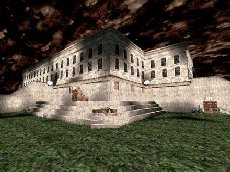
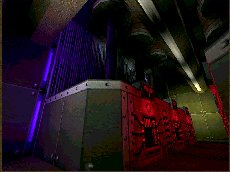

March,
14: New H3D
announcements: Daikatana by IonStorm, Sin by Ritual and Ultima IX - Ascension
by Origin. The title NHL'98 by EASports vanished from the announcements.
For
full overview visit my Announced Games
page.
===========================
-
March,
10: German
market page updated, especially software. Nihilist and Nascar now available
for a few pennies at PEARL. Several prices dropped considerably.
===========================
-

March,
10: The CyberMaxx is still (or again?) available
at Schiwi, Germany. The price dropped
to DM 298,- (about $165) including tax. Found it in the News-section of
the March 9, 1998 electronic catalog. Well, if there's a cheaper stereoscopic
HMD with headracking and audio I'll drop dead, but I'm still not convinced
though. Don't know what to do with it. Maybe I'll think again when it falls
to DM 99,- <G> .
===========================
-

March,
10: HMD manufacturer Optics
1, Inc. introduces it's new model E-ZView (initially called Viewtek)
this spring. The E-ZView and most other Optics 1 products are available
in monoscopic (as shown above) and stereoscopic versions.
(Thanks
to Optics 1 for keeping me updated.)
===========================
-
March,
10: The Woobo
page is under heavy construction at the moment. Let's hope for some
hot hardware news when it reopens.
===========================
-
March,
10: The H3D
website was completely overhauled. Here are some highlights: Glide
2.45 coming soon, H3D-GL-Quake2 coming soon (this week), H3D-OpenGL support
for Rendition coming soon, support for 3D-image viewing coming soon, 3D-videos
announced.
One
interesting detail: H3D recommends certain Sony monitors to reduce ghosting.
It seems that Trinitron tubes or at least some Trinitron tubes got a quite
short persistance time.
===========================
-
March,
8: I strongly recommend to download the StereoGraphics
Developers' Handbook and the CrystalEyes™
Software Development Kit Handbook in Acrobat format from the StereoGraphics
website. It's like getting two excellent books on Stereo3D principles
and programming for free.
The
books are updated regularly and contain almost up to date information.
Here's
a highlight from the SDK-Handbook:
"The FireGL 4000 3D graphics board
from Diamond Multimedia Systems is equipped with internal sync
doubling circuitry. This provides
a convenient technique for supporting stereoscopic applications which
already use the popular "above/below"
display format.
Since the sync-doubler is already
built-in, no additional accessories are necessary to plug in-between the
graphics board and the monitor
connector.
Stereoscopic eyewear plug directly
in to the mini-DIN3 stereo sync connector, which has been proposed as
VESA standard. The user has the
choice of plugging in the IR emitter for wireless CrystalEyes eyewear,
or
the direct-drive wired SimulEyes
eyewear.
Additionally, the function of toggling
sync-doubled stereoscopic display on and off is under control of
software. Unlike the external sync-doubling
emitter accessory, the user does not need to press a manual
button to enable or disable the
sync-doubled stereoscopic display. Instead the application can make the
equivalent driver function calls
to enable or disable stereoscopic display according to the appropriate
stereoscopic or monoscopic display
context.
In order to make such hardware-specific
function calls to the stereo-ready FireGL 4000, the application
makes use of the OpenGL."
Copyright:
StereoGraphics
Now the question is which
other VESA3-graphics boards got a built-in sync-doubler. I don't think
consumer cards like the FireGL1000, the Hercules Stingray or Thriller got
it.
There are some hi-end graphics
boards and workstations providing built-in sync-doubling too.
A note on the SimulEyes.
The passage about the SimulEyes in the text either refers to a future DIN-3
version of the SimulEyes or to a replacement DIN-3 cable for the controller
or it's just wrong! (IMHO)
For instructions how to
build a replacement cable for the current SimulEyes controller refer to
my homebrew-section.
===========================
-
March,
8: I did it again, I've added another chart
to the Technology page. This time
about "3D-Image formats and
how they are displayed - a line-by-line approach". It complements the
other screen-format charts. I know it's enough already, but maybe it'll
be of some help. I just love to do charts.
===========================
-
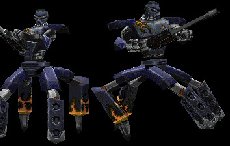

March,
5: As you might already know the Quake Total
Conversions X-Men
and Malice
run on the standard Quake-executable and as such work with the H3D-Quake-patches
by default.
The
command line options look like this:
c:\quake\h3dglquake.exe
-game xmen -xmen
c:\quake\h3dglquake.exe
-game malice -malice
===========================
-

March,
4: The Glide (Voodoo)/ H3D
Eyewear patch
for Andretti Racing
is available at Avault.
The official H3D website will follow.
===========================
-

March,
3: The 1997 helicopter simulation "Hexagon
Kartell" from Ascaron is a budget title now, at least in Germany. I saw
it at GameIt for DM 29.95 ($ 16). The
Stereo3D & Headtracking patches are available at Ascaron.
AFAIK the stereo3D mode is also available in hi-res. There's at least native
support for VFX, i-glasses and 3D-Max. The Max mode should work for 3D-
and VR-BIOS. With a little luck it'll work with LCD-BIOS or at least NuvFrag
too.
===========================
-
March,
1: I did a bit of brainstorming on the H3D
Control Pattern.
Would
a H3D-"Synthetic" Interlace hack help programs like Terminal Velocity,
Comanche3 or Armored Fist2 ??? I doubt it!!! The
mode works only from 85 Hz upwards. It's very hard to get the low-res modes
of this games up to that refresh. I also doubt that "synthetic" interlace
will work on modes below of 640x480. Another problem is the way VGA-boards
handle those low-res modes. They use line-doubling by default. This will
most likely screw the whole thing. All those lo-res standard VGA-mode programs
are a pain in the ass, no matter on what shutter-system. I hate them all.
Programs using VESA-modes on the other hand work like a charm on almost
any system. A pattern hack for Descent2, Nascar Racing, Hexen2 and for
the windows desktop is conceivable however.
Would
a page-flipping pattern hack for all the LCD-/3D-BIOS titles and for MDK
work? Yes, it might work - in theory.
Would
a Top-Bottom hack help Duke Nukem 3D?
I doubt it, because there is no way to calibrate the screen. It might look
terrible. The TB-mode in Duke3 was made for the CrystalEyes Sync-Doubler.
H3D
will not come forward with any such tools. They even decline to offer a
utility to set the windows desktop to interlace. There is no way to run
any non-H3D stereo-application (like 3DEM) on the windows desktop without
trickery.
===========================
-
March,
1: The latest version of 3DEM
(v.6.04) brings back the 8-bit stereo3D animation format from 3DEM 5.x.
Now anything goes. Get
it for free.
===========================
-
Feb. 27:
New APEC
products:
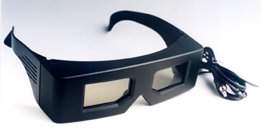

1)
New version of the VirtualVisor, now with VGA-pass-through controller!
It's basically the "VR97" plus a game bundle (Descent2-OEM, Whiplash, Slipstream).
The product should behave just like the VR97, the i-Art VirtualEyes and
the homebrew VGA-PT. Go to the VGA-PT
page for driver&software compatibility lists.
2)
32" 120Hz (NTSC) TV with wireless glasses
(comming soon).

3)
New ultracool "GOLD" glasses. Weight: 50 g. The gold filter can be pulled
up, the shutter-unit is removable. Can be used for TV and PC applications
- and as sunglasses (comming soon).
4)
Components for the 3D Live Video
system. (3D-adaptor for camcorders, digitizer card, shutterglasses
for monitor-viewing, polarization controller, splitter and glasses for
projection systems.) Do your own digital 3D-movies, using your humble standard
camcorder! There's a diagram
of the system and a pic of the camcorder 3D-adaptor on the misc page.
(Thanks
to APEC
for the exclusive infos.)
===========================
-
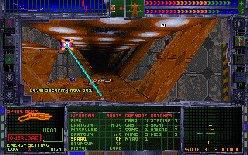
Feb.
26: System Shock again. Is there
anyone who got into the "video - headset" option-menu WITHOUT a VFX-1 controller
card installed? Please contact
me!
===========================
-

Feb.
25: Just got word from Interplay
that there is NO (!) Stereo3D/VR support
in "Descent to Undermountain" and
NO plans to add such functions later. The program is based on the "Descent"-engine
and was announced on some shutterglasses manufacturer pages.
===========================
-

Feb.
24: If you're still using one of those dinosaurs,
Navigator or Explorer you should give Opera
a try. It does the same things, but it's much faster, much smaller and
it got a ZOOM function. In other words it comes in handy for those oversized
comparison charts of mine. Oh, yes, it supports JAVA and Navigator plug-ins
of course. It's a 1 (read my lips: ONE) MB download. What I need now is
a html-editor of the same speed and quality.
===========================
-
Feb. 23:
Some people asked me for a stereo3D
capable VRML viewer. Well, with a little
help of the nice "Anaglyph
Software List" (a fellow member of the Stereo3D
Webring) I found one. The Hybris
VRML viewer supports anaglyph and "StereoGraphics" format. The software
is in beta and can be ordered by email from the author. I don't know what
"StereoGraphics" format exactly means. Most likely it's Top-Bottom format
(for a sync-doubler), but it might be as well page-flipping or interlace
format. Either way we have to talk the programmer into supporting all formats
:-) .
===========================
-
Feb. 23:
Pics of IMAX3D Shutterglasses and some new
IMAX infos added to the movie page.
===========================
-
Feb. 18:
The Cybertec link
is dead. I can't find them anywhere else. Are they gone forever?
===========================
-
Feb. 18:
Links page
updated.
===========================
-
Feb. 18:
Sun's Java3D nears completion. I don't know
if there are stereo functions in this new graphics library yet.
===========================
-
Feb. 18:
As you might already know Forte has turned into Interactive Imaging
Systems. The new adress is www.iisvr.com.
They're still working on the new VFX-3D hi-res consumer HMD.
===========================

-
Feb. 18:
Added Virtual
Max System to the TV/Video-Shutterglasses
chart. The product is targeted at the adult video market.
===========================
-
Feb. 18:
Heaven on Earth for all 3D and
VR freaks is at the FUTUROSCOPE
in France. Visit their website, it's a MUST SEE. They got everything: IMAX,
IMAX-3D, IMAX Solido, IMAX Magic Carpet, OmniMAX, VR-machines and much
more. ALL in one place. All packaged in an incredible architecture. (It's
basically a theme park for imaging-technology addicts. - Who needs Euro-Disney?)
There's a pic
which shows a whole movie theatre full of people wearing..., NO not polarization-glasses,
but SHUTTERGLASSES!
At Futuroscope they use
polarization for IMAX3D and shutters for IMAXSolido. I don't know if this
applies for all IMAX installments or if there are IMAX3D theatres using
shutters too. I remember a TV report about "Wings of Courage" (IMAX3D),
where all people got giant shutter-helmets with audio system. Never saw
this helmets again.
===========================
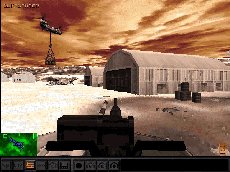
-
Feb. 17:
There is stereo3D support in Novalogic's
Armored Fist 2,
even in the demo version. The hotkey is
ALT-F6. Works with HMD's or VR-BIOS (VRex).
Should work with 3D-BIOS (3D-Max) too (try Max3D util in case of split-screen
error). NuvFrag showed a buggy result, but maybe I gave up to quickly.
AF2 usually works at a fixed resolution of 640x480 and got lots of different
views (in tank, on tank, behind tank, maps, etc.) The stereo mode is limited
to one view (on tank, full-screen) and to low resolution (320x240?). It's
similar to the Comanche3 stereo-mode and isn't very impressive. The reason
for the low resolution lies in the limitations of consumer HMD's. There
should be a special hi-res mode for shutterglasses. The sad thing is that
the required algorythms are there already. Should be very easy for the
programmers to do a 640x480 stereo mode, even easier than the lo-res mode.
This hi-res stereo mode could also work in the other in-game views. Unfortunately
it won't happen.
(Thanks
to Novalogic support for the info.)
===========================
-
Feb. 16:
New Shutterglasses page in ITALIAN
language from my fella Matteo. The focus is on SimulEyes/Fanatix, Quake
& 3D-links.
===========================
-
Feb. 16:
Still looking for a good stereo-image utility? Give the 3D Stereo Image
Factory a try. It supports stereo-JPG (JPS) format, interlace and anaglyph.
It's fully functional shareware. A 4 MB download at SOFTreat.
There's a stereo image gallery on that page too.
===========================
-
Feb. 15:
3DEM v.6.03 is here.
Now supports all windows desktop interlace compatible shutterglasses at
all desktop resolutions & 16/24 bit color depths. (Compatible drivers
are: 3D-BIOS, VR-BIOS, SSDI, 3DWin, SGToggle, VRViewer and others. Not
much hope for WinSpex though.) Monoscopic mode and red/blue-3D are still
available. It also supports OpenGL now. No hardware 3D-accelerator required,
software emulation does the trick. It's also quite fast now. The 256 color
mode and the special stereo3D-animation format from version 5.0x are gone
for now. Programmer Richard Horne set up a new dedicated
page for 3DEM, with binaries, images, videos, links. Watch Earth, Mars
or whatever terrain in incredible detail and in stereo3D, like the pros
from NASA. 3DEM is a MUST HAVE and it's Freeware.
Program
description (taken from the manual):
"3DEM will render 3D terrain scenes and MPEG
flyby animations from USGS Digital Elevation Model (DEM) files, USGS Global
30 Arc Second Elevation Data Set (GTOPO30 DEM) files, NASA Mars Digital
Topographic Map (DTM) files, or any topographic data file which is organized
by rows and columns of elevation data. 3DEM will also produce realistic
fractal landscape scenes. 3DEM uses the SGI/Microsoft OpenGL libraries
for high speed 3D rendering.
3DEM will render
16 or 24 bit color three dimensional projections, red-blue projections
requiring red-blue 3D glasses for viewing, or color 3D projections requiring
Liquid Crystal (LCD) electronic shutter glasses for viewing. Completed
scenes can be saved as Windows bitmaps for transfer to other applications
or as 16 bit height field bitmaps for use with the POV-Ray ray tracing
software. Flybys can be saved as mpeg animation files which
can be played back with freely available Windows 95 mpeg player software."
(c) Richard Horne
===========================
-
Feb. 15:
Check out the Starmap-3D
homepage, or follow the other link directly to the Starmap-Stereo3D-page.
Webmaster Winchell Chung is thinking about a stereoscopic Starmap application.
===========================
-
Feb. 14:
3D-Boards page updated. There's a
new entry: "California Graphics - 3D Emotion" and a list of cards one might
think they got a glasses connector, but DON'T.
===========================
-
Feb. 13:
I've updated the Misc
page a bit since Don Sawdai gave me some info on polarization
technology. Products like the Stereographics
Z-Screen are active. They're quite similar to shutterglasses, the shutter
just sits on the screen instead on your nose. Such polarization shutters
require a standard (tube) monitor, just like shutterglasses.
Passive
polarization products, like the VRex Cyberbook, on the other hand work
with LCD-screens only. I never had the chance to see it, but those passive
systems must be really cool. No flicker, very light glasses, no batteries,
no cable, no interlace, no page-flipping, no electronics, nothing. That's
real 3D, without a time lag. Both eyes see the image simultaneously, not
just by turns, as with shutters.
Sometimes
in the future when LCD and Plasma, or something like that, becomes dominant
over tube-monitors we don't need (can't use) shutterglasses anymore, just
some $1 cardboard polar-glasses. The LCD-screen has to be prepared for
this of course, by polarizing the odd lines in one way and the even lines
in the other. That's possible, because on a LCD-display the lines are always
in the same spot. On a standard tube-monitor the position of the lines
changes from screen mode to screen mode and from setting to setting. If
the lines on our monitors were fixed we could apply some polar-foil to
it, but that's never gonna work.
===========================
-
Feb. 13:
Please read Donald Sawdai's comment
on the LCD-BIOS page-flipping slip-ups affecting VGA-pass-through systems.
(See the drawback-section
of the VGA-PT page.) Here are the highlights of his comment:
"LCDBios
always uses SW page flipping."
"SciTech's
drivers sometimes made this worse."
===========================
-
Feb. 13:
The upcoming H3D-GL-Quake2 should work on
any 3D-board with a suitable OpenGL driver, like Voodoo, Rendition and
others, but only the new 3DFX-GL/Glide driver will show the H3D-control-pattern.
This could lead to the "funny" situation that H3D-GL-Q2 might work on non-Voodoo
boards using 3rd party glasses like i-Art VirtualEyes, APEC VR97 or the
homebrew VGA-PT, but NOT on the original H3D-glasses. As stated in an earlier
message H3D tried to work with Rendition on this, but there seems to be
not much interest on Rendition's side. H3D Eyewear is targeted at the mainstream
market and this means Voodoo. The Monster3D alone sold 800,000 units. H3D
is still the only consumer shutterglasses system which supports the Voodoo
Graphics at the moment.
H3D
is still confident to get all other VGA-boards working. Their SDK supports
DirectX, Glide and OpenGL.
===========================
-
Feb. 13:
It seems in some new Rendition V2200 board
designs the VESA3-glasses port is replaced by a S-Video IN port.
===========================
-
Feb. 12:
Applications and Edu
slightly updated.
===========================
-
Feb. 7:
There's a new H3D-review on Bjoerns
3D-World.
===========================
-
Feb. 7:
X-Ray lab modified, driver column added
to Hot-Games, "dream configuration"
added to buying guide and more
minor updates.
===========================
-
Feb. 6:
VGA-PT controller drawback-section
updated. Trouble with LCD-BIOS in many (?) cases.
===========================
-
Feb. 6:
"Hodie" wrote a little
tweak for HMD support in Hi-Octane.
It has to be used in conjunction with the normal 3D-patch. It delivers
a non-interlace-mode, non-page-flipped alternate line image. LCD- or 3D-BIOS
isn't required. It doesn't work on my system, but hey my box is one mess
anyway - non-adaptec-SCSI, no-name-network, General Midi, 3D-Max-board,
no-name-sound, TV/Video, ISDN (doesn't work of course), non-intel chipset,
non-intel processor, PS/2 mouse.
===========================
-
Feb. 5:
Scitech Display Doctor contains the following
univbe command line option. univbe
on hwstereo
Looks
like a software switch for the VESA3 glasses port, but I can't test it.
===========================
-
Feb. 5:
I found this on Björn's
3D World page: "According to the guys at H3D (the gys with the glasses)
Rendition hasn't yet seemed interested to help them make a rendition version
that works with the glasses. So raise your voice on the rendition newsgroup
if you are interested in a H3D-version that works with the Rendition cards."
Hmm,
I thought they were working on a GL-version which works on all OpenGL video
boards.
===========================
-
Feb. 4:
And the winner is...
The i-Art
VirtualEyes review is here! The first wireless
consumer glasses with plain (!) VGA-path-through controller! Syncs to anything!
Large LCD-panels! Stereo reverse button! Brilliant power supply solution!
Great software package! Top documentation! - I love it!
Any
drawbacks? Well, the nose-piece is as (un)comfortable as the one of the
3D-Max. The price for the premium hard- and software package (VRWorks!)
is $250. Hey you get what you pay for. The software alone is a $200
value. And last and least it won't work on Voodoo add-on boards.
The
whole product was designed with the multimedia user in mind, not so much
for gamers. Ironically the i-Art hardware got the best game- compatibility
of all commercial products I've tested so far.
Unfortunately
the package lacks a DOS-Interlace driver like VR- or 3D-BIOS and there's
none available on the net (AFAIK). LCD-BIOS and it's "relatives" can be
used instead of course!
The
VirtualEyes are also presented in the X-RAY
Lab already!
===========================
-
Feb. 4:
The Forte Homepage was updated! (Thanks
to Bhanu for the hint!)
===========================
-
Feb. 3:
Have you had your share of radiation today?
No? Report to my all
new X-RAY Lab immediately.
===========================
-
Feb. 2:
Homebrew Sync
Doubler circuit available. This one was made by
Florian Schreck. It's hand-drafted. A printed circuit layout will follow.
The Jörg
Fischer Crew still works on the Sync Doubler plus Line Blanker circuit.
===========================
-
Feb. 1:
I found the first (?) two DVD movies in 3D. Dinosaurs
& Other Amazing Creatures in 3D in anaglyph (?) and Girls
Wet & Wild 3D in anaglyph or pulfrich (?). Both from Simitar.
No shutterglasses stuff yet. (The "wet girls" CD seems to be a cross between
a bucket of water, a suntan lotion commercial and a sleeping pill.)
===========================
-
Feb. 1:
Slipstream does react to the refresh rate set by Display Doctor 6.0 (UNICENTER-Util),
at least sometimes. No luck with Whiplash yet. Any idea?
===========================
-
Feb. 1:
Just another commercial 3D-Max-page.
Nothing new there.
===========================
-
Jan. 31:
Silicon Graphics
put up a dedicated Virtual
Reality page.
===========================
-
Jan. 31:
VRex opened
a new additional website for distribution: 3D-Outlet!
It's under construction, not much to see there yet.
===========================
-
Jan. 31:
I checked the Armored Fist 2 demo today. It
uses the same engine as Comanche 3,
but there is no option to set graphic modes. It's stuck at 640x480 (?).
I fear the retail version looks the same. No stereo option of course.
I can't find anything with the disk editor also.
===========================
-
Jan. 30:
Found another board with shutterglasses connector:
CyberRex Wizard VGA Board
+ Virtual Reality Package.
===========================
-
Jan. 30:
Woobo added
nice new 1998-"estimated release dates" to their good ole "games in development"
list. Well I'm sceptical, but hey - go ahead - surprise me.
===========================
-
Jan. 30:
Some new pics on the VRSurfer
page. Some minor changes all over the website.
===========================
-
Jan. 28:
I'm still looking for a way to increase the
refresh rate in standard VGA-modes. Scitech Display Doctor does it's magic
only on VESA modes. There's a utility for Rendition cards which remaps
the VGA-modes to VESA. Is there something like that for other chipsets
too?
===========================
-
Jan. 28:
Sorry, but I have to nag again about System
Shock. What has to be done to highlight the "HEADSET" option in the Video
menu? Must a headset driver be present to activate this? If so what headset?
VFX-1 or CyberMaxx? Is there a command line option? Maybe a set-variable
in autoexec.bat does the trick? Is there a hotkey? Or is there something
wrong with the european version? I'm using cdshock.exe vF1.6C. Please answer.
===========================
-
Jan. 27:
The Jörg Fischer homebrew3D team is hooked on the line blanker (synthetic
interlace) of the H3D-box since I described it here lately. They'll try
to include it into their new design.
===========================
-
Jan. 27:
New version of QLCD
for Dos-Quake & SimulEyes/miro available. Now the VGA-mode number
hasn't to be set manually anymore.
===========================
-
Jan. 27:
New VGA-card with VESA3-stereo3D-connector: Genoa
V-Raptor 3D. Very similar to the Hercules Thriller (Rendition V2200).
===========================
-
Jan. 25:
Please check the new
VR-homepage of Denis Bolic. Contains info on stereo3D and headtracking.
There's a nice 3D-picture too.
===========================
-
Jan. 25:
Just found out that the stereo versions of
Whiplash and Slipstream know the following command line options:
Whiplash:
whip /simuleyes /simuleyes70 /simuleyes80
/lcdbios /fx480
Slipstream5000:
slipstrm /simuleyes /simuleyes70 /lcdbios
/maxx /r /novbe
Unfortunately
the /maxx option seems to be buggy in my version of Slipstream. Would be
very good for systems like 3D-Max and VR-Surfer.
There
might be other versions of this two programs. Scan the exe-files for keyword
lcdbios. The other options will be visible too then.
Maybe
someone can tell me if there
is anything in the retail versions of this programs.
===========================
-
Jan. 25:
Please read the new DRAWBACKS
section on the homebrew VGA-PT page.
===========================
-
Jan. 25:
Does anyone know how to get headtracking working
for Quake 1&2 and the i-glasses? Do you have any drivers or patches
for the i-glasses? Please send
me email. (Please, don't send files to my mailbox, just tell me about
them.)
===========================
-
Jan. 24:
New: Scandalous
Nude Picture.
===========================
-
Jan. 23:
Urgent: VRex
VRSurfer Classic Pack at EBAY
online auction. 50 units to be sold. Minimum bid: $15. Only 4 days
left for bidding! The bids are very low, you might get a VRSurfer for $30-40.
(Thanks to Lance.)
===========================
-
Jan. 23:
Homebrew VGA-Pass-Through controller
review and software-list!
===========================
-
Jan. 23:
Homebrew-3D specialists Thomas Schuhmann and Franz Krause finished their
VGA-pass-through printed circuit layout, based on the basic circuit of
Jörg Fischer and Michael Bosch which is based on the circuits of s
by Tomi Engdahl and Martin Krysiak, which is based on... heck I don't know.
You see there are a few people working on this stuff. I'm testing the TS/FK-controller
at the moment. Everything goes! Beats out
many commercial shutterglasses controllers
when it comes to software compatibility. Thomas and Franz also compiled
a hi-res 3D-photo CD-Rom especially for WinSPEX, but it can be compiled
for other 3D-drivers too. CLICK
HERE.
===========================
-
Jan. 23:
The Jörg
Fischer/Michael Bosch page should be updated also in the meantime.
They're still working on a sophisticated VGA-pass-through controller with
Sync-Doubler!!!
===========================
-
Jan. 23:
I've added comments by LCD-BIOS/SSDI author Don Sawdai to the Technology
page. Everything you always wanted to know about Page-Flipping and Interlace
but were afraid to ask. Very enlightening!
===========================
-
Jan. 23:
Message by Stefan Schimanski: "I've changed qlcd a bit. Now it's simpler
to use because you need not to
know
which number your vesa mode has. I've tested it with LCDBios 1.31 and a
miroMedia
3d with Virge chipset." http://1Stein.home.pages.de
===========================
-
Jan. 23:
Take a look on Grendels
Gamelist. It covers many headtracking games and some stereo-games.
(Thanks to Hodie)
===========================
-
Jan. 23:
Forte, or whatever they're called now, is still working on the next generation
VFX-3D helmet. (Thanks to Marc.)
===========================
-
Jan. 23:
i-glasses software list and a few drivers on the Mindflux
page. (Thanks to Jimmy.)
===========================
-
Jan. 21:
Breaking news: H3D-controller
does Miracles! You
thought the Sync-Doubler in the H3D-box was a little sensation? Well it
was, but what I found out now will blow you away. The technical novices
might not understand this, but you experts better buckle up! It's unbelievable,
yet proven. Yesterday I would have bet a $$$1000 against it, but it's true.
I saw it. I put it to the test. The H3D-controller
can generate interlace out of thin air. I
had to check back with H3D-engineering because I thought I'm loosing my
mind.
VGA
card and monitor are in normal non-interlaced/non-page-flipped mode, no
sync doubling involved, resolution & refresh are normal, but your eyes
see interlace. How is this done?
Here
you go: The H3D-controller scans the frame
and blanks out the odd lines. In the next frame the controller blanks out
the even lines and so on. The refresh rate and other parameters aren't
changed. The lines are still there, they're just black now. This is not
even page-flipping. It's what I would call "synthetic interlace", without
the participation of VGA-card or monitor. No software driver is involved.
The H3D-box does the job.
In
the future this can be used to set the Windows desktop into this "synthetic-interlace"
on any, I said ANY (!!!) VGA-hardware. That way you can watch interleaved
stereo images on the web or use other interlaced (alternate line) software
on your windows desktop (or somewhere else maybe), without tweaking your
graphics hardware (that's what all the other systems do). The H3D-control
pattern is still required to activate the glasses of course. Software which
activates
this mode isn't officially available yet. Please be patient.
===========================
Jan.
21: It seems
Voodoo2 won't support hardware page-flipping,
opposed to earlier statements on this site.
H3D
will use split-screen (sync-doubler) format for the V2, just like on the
Voodoo1. Due to the bigger RAM of the Voodoo2 there will be a special hi-res
mode (640x960) which will look just as good as the line-doubled page-flipping
on Voodoo Rush and Rendition.
===========================
Jan.
21: The program 3DEM
5.0 (3D-Digital Elevation
Model) by Richard Horne calculates
3D-landscapes
and ray-traced flyby animations.
Several professional topographical data formats, like NASA's
Mars surface data can be imported. The animations
can be saved as MPEG or as a special Stereo3D-animation
format. 3DEM supports Anaglyph (red/blue)
and SimulEyes format on the windows desktop. It works with some other shutter-systems
too. There's one problem however. 3DEM insists on setting the interlace
mode by itself, instead of leaving this to 3rd party drivers (like 3D-BIOS,
VR-BIOS, SG-Toggle, etc...). This may cause problems with some VGA-chipsets
and glasses. Interlace mode is available in 800x600@256c only. I contacted
the author and asked for a fix. The freeware
(!) file (<500kB) is available from http://download.com,
search term: 3DEM. (Thanks to Chuck
Miller for the hint.)
===========================
-
Jan. 21:
There's a short and very positive review of
the Hercules Thriller at Next-Generation.
AFAIK
only the 8MB version of the Thriller features a VESA3 shutterglasses port.
===========================
Jan.
21: After my "raw-egg" statement in the review,
H3D pointed out that the eyewear is more damage-resistant than the light
design might imply. They were tested under rough conditions and should
survive all minor "accidents". No reason to be rude though.
===========================
Jan.
21: The H3D infrared transmitter is connected
to the controller box through a mini-DIN3 jack. The transmitter isn't compatible
to the DIN-3 jacks on VESA3 graphics boards (Stingray, Thriller, FireGL
etc.) though. Don't try it. The H3D system fits to all graphics cards anyway
due to it's VGA-pass-through connector.
===========================
Jan.
19: H3D
Eyewear tested.
===========================
-
Jan. 18:
HMD-chart
slightly updated.
-
Jan. 18:
If you're a System Shock fan you should sign
the System Shock 2 petition.
-
Jan. 18:
Check this website: www.vrnews.com.
Not much to see on the page, but you can order a free trial subscription
of VRNews-magazine there.
-
Jan.18:
Here's an interesting comment
about H3D, Glide, OpenGL and the currently developed Uberengine.
-
Jan. 17:
New Shutterglasses!
The i-Art Virtual Eyes are wireless,
connect to the VGA-port and feature a stereo-reverse button. The price
is 100 bucks. A TV/Video-version is available also. The VirtualEyes utilize
interlace mode under Windows and they seem to be compatible to LCD-BIOS
and other drivers under DOS too. That would mean they sync to any interlace
and to any page-flipping screen. I would give it a "Thumbs UP", but I can't
do this without a hands-on test. The i-Art
website is worth a visit. There's a nice introduction to stereoscopy
and a picture gallery. I-Art offers some stereo applications for windows
too: "VRWorks!", "VRShow!", "Virtual Gallery" and the driver package "3D
Win". No free downloads yet. You might also check my updated shutterglasses
chart. The software and driver
charts are also updated accordingly.
-
Jan. 17:
I've put a list of video/TV-compatible glasses
on the movie-page.
-
Jan. 17:
The H3D-Quake2-Patch has been delayed. (Thanks
to Armand and "tucka"
for the bad news.)
-
Jan. 16:
ForteVR (makers of the VFX-1) declared bankrupcy!
The same guys continue their work under a different name: Interactive Imaging
Systems. I wonder what happens to their next generation product: "VFX-3D".
(Thanks to Bhanu for the info.)
-
Jan. 16:
I was supposed to be one of the first to test
the H3D eyewear. Now it turns out I'm becoming the last one, if I should
see the thing at all.
-
Jan. 16:
ImageTech cameras added to misc page.
-
Jan. 16:
Found some more
HMD comparison charts out there on the web.
-
Jan. 15:
Gallery
opened. Unfortunately I haven't got the web-space to present lots of pictures.
-
Jan. 15:
Credits,
movie, misc updated.
-
Jan. 13:
Jimmy
Chu offers free webspace for i-glasses drivers and patches. Please
hand drivers and stuff over to him for publication. He got nothing so far.
-
Jan. 13:
Computers and More - worldwide
VR Gear distributor offers free CyberMaxx
2.0 Drivers and Patches. Just go there
and drop them an email. (Thanks to Armand
W. Bastien of Computers
and More.)
-
Jan. 13:
New, extended Miscellaneous
(former "Exotic") page. (Under construction.)
-
Jan. 13:
Michael Jackson
shots added. (Huhhh...?)
-
Jan. 8:
The VRSurfer works on Magic Carpet
2 (no patch required). Use force3D,
start with option -vio,
press S to toggle
stereo. There's a split-screen error at first, but it vanishes after stereo
is activated. Ghosting is quite visible in the "night"-levels (what a surprise).
I wonder why it didn't work on 3D-Max. Maybe I haven't tried hard enough.
-
Jan. 7:
Links-page
enhanced!
-
Jan. 7:
The i-glasses (PC/TV version) are now also
available from MS-EDV, Germany for DM
499,99 (about $280). I'm still uncertain if all this dealers just sell
remainders of the i-glasses or if anyone produces this stuff again. The
very cheap i-glasses on the german market are remainders I guess.
-
Jan. 6:
"Honey, I blew up the VRSurfer
page!"
-
Jan. 6:
Movie page
updated with lots of new VHS-video titles for shutterglasses.
-
Jan. 4:
It seems the game Nihilist by Philips contains
at least some stereo3D support. I guess it's anaglyph (red/blue) only.
Maybe someone can check this? (Thanks to David
Day for the info.)
-
Jan. 4:
New (!?!) 3D-Max adress in Korea: http://intervr.castmail.co.kr/,
contains some downloads. (Thanks to Rick
Jongbloed.)
-
Jan. 4:
There is a new
i-glasses website: . (Thanks to Thaddeus
Elms for the link.)
-
Jan. 3:
I added specific compatibility info on the
VRex VRSurfer to the Hot-Games page.
Look for "VRS" titles. Maybe there will be a few more, but I have to figure
them out first.
-
Jan. 3:
I did it again! I've made just another
table full of images to explain the difference between interlace,
page-flipping and sync doubling! This time
from the VGA-card point of view. Maybe it'll help a bit.
-
Jan. 3:
There's a Shattered Steel update patch on
the Bioware page. It contains native LCD-BIOS
support and other goodies. (Thanks to Eyal
Teler for the news.)
-
Jan. 3:
I received a VRex
VRSurfer system
(classic and web pack) for evaluation yesterday. It does more than I expected
in some cases and less in others. It behaves very much like the 3D-Max.
More info on this later.
-
Jan. 1:
You have to remove SET
FX_GLIDE_SWAPINTERVAL=0 from your autoexec.bat
to get H3D-GL-Quake working. (Thanks to Matt
Barrett, Visual Clan.)
-
Jan. 1:
There are updated DOS- and GL- Quake1 patches on the H3D page.
-
Jan. 1:
|
Gutes
Neues Jahr - Happy New Year
|





















 I must be dreamin' !!! Nuvision
(the SPEX-guys) did Stereo3D-WinDOOM for WinSPEX !!! Might work with Doom2
etc. too! It's not a first rate stereo conversion, but a technology demo
to show how easy it is to do stuff for WinSPEX. Go to the Nuvision SPEX-Doom
page! BTW, this port isn't authorized by "id" !
I must be dreamin' !!! Nuvision
(the SPEX-guys) did Stereo3D-WinDOOM for WinSPEX !!! Might work with Doom2
etc. too! It's not a first rate stereo conversion, but a technology demo
to show how easy it is to do stuff for WinSPEX. Go to the Nuvision SPEX-Doom
page! BTW, this port isn't authorized by "id" !




















